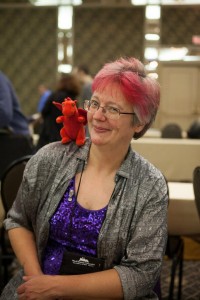
The book is scheduled to be released at Emerald City Comicon next year, so you may see why the time pressure has stepped up in intensity. I told myself I’d get it done this year, and I have, along with a whole bunch of stories, not one but two collections, the update of Creating an Online Presence for Writers, a bajillion trips, and opening the Rambo Academy for Wayward Writers, including cool new classes from Rachel Swirsky and Juliette Wade, so I feel darn good about how much I got accomplished this year despite SFWA’s demanding maw chewing up my time on a consistent basis.
I thought, however, it would be useful perhaps for people grappling with novels to see what the last bits of work involve. I’ve been incorporating edits from the hardcopy manuscript but still have lots and lots of comments in the e-copy to address. In the process of adding those, I was able to look at the manuscript from a high-enough level that I could sort out all the chronology (oh dear GODDESS please let that statement be true, because that’s been the biggest pain in the rear so far) and make sure that everything made sense, that storylines were resolved, and that all the hidden plotlines got bubbled up in a meaningful way.
I’m adding in a few stray scenes that got dropped somehow, and then I’ll do the following passes (this is taken from the TODO list currently hovering at the beginning of the manuscript in Scrivener).
I’ll get through as many of these today as I can, but at some point I’ll have to print it out, because I want to take it on the road with me. I’m headed to a conference on nonprofit storytelling (ha) on Wednesday and back on the 13th, which is a complication I really wish I hadn’t introduced into my life, along with a class I’m teaching on the 12th (ditto the regret for the timing, but it’ll be a fun class), which is one reason I deserve a little Skyrim next Monday.
Anyway, here’s the todo list that I’ve been making as I went through and added my edits in:
Do a search on:
“¢ One of, not for the first, little, square
“¢ Penny-wides (penny)
“¢ Swam, abandon, tilt
(These are words I’ve noticed I use a lot, and I want to make sure they’re not over-used or consistent.)Points that need to be checked or addressed:
Position of Temples on Beasts
Is Lucy set up as a name?
Are there too many duplicate things, like Lucy getting dismissed twice, multiple fights with Eloquence, etc? Outline events and examine.Echoes:
Terra-cotta trade god dolls
Riot and Duke’s OccasionPasses that need to be made:
“¢ Titles and capitalization
“¢ Read through each person’s story and map out times against BoT
“¢ Mapping pass – streets align
“¢ Trade God pass, check all the names against morphology
“¢ Names – consistent Bannister/Faustino, Serafina/whatserface, Marta/Ruhua, all of Elo/Obed’s sisters
“¢ Thought patterns (x 4)
“¢ (spoiler removed) clues
“¢ Mother references from Elo and Obed
“¢ Motivation for Lucy’s (spoiler removed)
“¢ Passes on significant locations: the stables, Sebastiano’s bedroom, Adelina’s, College of Mages, Great Hive chamber, the press, Adelina’s office, Letha’s stillroom, Silvercloth breakfast room, Murga’s tent
“¢ Possible redundancies: Adelina’s hiding of the press, Dryad forest and furnace, orange paper, election explanation, Sphinx
With the passes, I’m going through looking at a specific aspect, usually. For example, looking at each time a particular location occurs in order to make sure there are no contradictions and that the successive iterations build on each other rather than being redundant. That was the biggest flaw (IMO) of Beasts’s multiple drafts, a legacy of how many agents and editors wanted changes to the point where the book got rewritten a dozen times.
So we’ll see. I think this is a better book than the first one, which is reassuring, but there is always that perhaps I am deluding myself and this is just a manuscript with all work and no play makes Cat a dull girl repeated over and over again feeling lurking in the back of my head when I get to this stage.
Now, back to work.
#sfwapro







33 Responses
Home Stretch For Hearts of Tabat: https://t.co/9m32tqcFsJ
You can do it!
What a year!! And what a great book it’s going to be. Happy birthday in advance. I will raise a glass of malbec to you in Buenos Aires.
K.c. Ball liked this on Facebook.
Randy Rambo liked this on Facebook.
Steve Gurr liked this on Facebook.
Kris Dikeman liked this on Facebook.
Sally ‘Qwill’ Janin liked this on Facebook.
Ronnie Virdi liked this on Facebook.
Andy Dudak liked this on Facebook.
Mike Navratil liked this on Facebook.
Go, Cat, go!
Yay!!!!
Dallas Taylor liked this on Facebook.
Matt Thyer liked this on Facebook.
Neile Graham liked this on Facebook.
Kelly Rambo liked this on Facebook.
Gay Partington Terry liked this on Facebook.
Trent Walters liked this on Facebook.
Lori Deason liked this on Facebook.
Chris Furst liked this on Facebook.
Kelli Stasi liked this on Facebook.
Kelly Mormann liked this on Facebook.
Tasha Turner Lennhoff liked this on Facebook.
Jaime O. Mayer liked this on Facebook.
April Osburn-Harris liked this on Facebook.
Marta Murvosh liked this on Facebook.
Les Howle liked this on Facebook.
Sean Berry liked this on Facebook.
Ron Horsman liked this on Facebook.
Danielle Myers Gembala liked this on Facebook.
Patty Saturn liked this on Facebook.